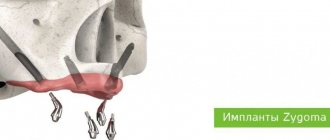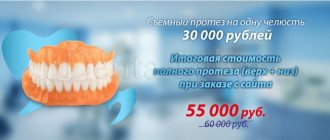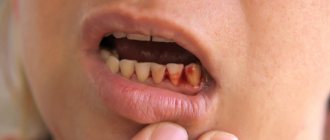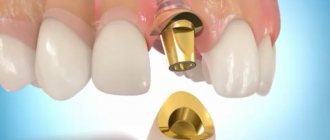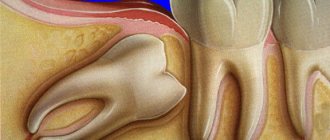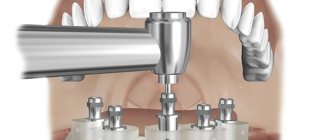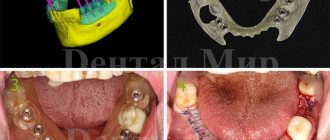The peculiarity of zygomatic implantation is the use of very long implant models that are securely fixed in the deep zygomatic bone of the upper jaw. Thanks to their use, it is possible to avoid bone tissue build-up, or more precisely, sinus lifting. If there are no contraindications, then on the day of surgery or a few days after it, the implant is loaded with a prosthesis.
Indications
- absence of chewing teeth (end defect) of the upper jaw,
- complete or almost complete edentulism of the upper jaw,
- problems with the jawbone after accidents, injuries, serious cancer,
- extreme bone atrophy of the lateral sections due to prolonged absence of teeth,
- the presence of inflammatory processes: periodontal disease, periodontitis, osteoporosis,
- impossibility of performing a sinus lift,
- old age of the patient,
- the need to quickly restore the aesthetics and functionality of the dentition.
Key Features
- elongated models of implants are used, which are attached to the zygomatic bone,
- zygomatic implants are installed at an angle,
- at the same time, from 2 to 10 more implants are installed per row to support a complete denture,
- instant load on the prosthesis,
- the bone does not grow,
- implantation is possible simultaneously with tooth extraction,
- three-dimensional modeling of the treatment process is used.
A contraindication to zygomatic implantation is the presence of inflammation in the nasal or maxillary sinuses, for example, after complex tooth extraction, viral or bacterial infections, due to various ENT pathologies. This limitation is explained by the fact that zygomatic implants, after installation, will border the lining of the sinuses, so the inflammatory process can spread to other tissues, which will lead to rejection of the structures.
Tatiana, 52 years old
“Now I can live a full life like a healthy person! I searched for a clinic for a very long time, but everywhere they only offered me implantation with a removable denture, but that took too long. Zygomatic implantation solved all my problems - I got a beautiful smile right away and teeth that can be fully used. Thanks to my doctors!”
- solving even COMPLEX situations
- WITHOUT bone grafting
- beautiful and functional prosthesis IMMEDIATELY
- you will become beautiful, forget about pain and discomfort
- start smiling and ENJOYING life
watch a video with the patient
Therefore, at the stage of preparation for implantation, after a computed tomography scan of the jaw and sinuses, treatment of inflammatory processes is necessarily prescribed. Only after complete rehabilitation can you return to the issue of treatment.
All-on-4 is a patented development of Nobel Biocare. This is the 1st company in the world that created dental implants and the No. 1 brand in the world market. The Smile-at-Once Clinic is a clinical center at the Nobel head office in Moscow (we are within walking distance, with access to the entire arsenal). Implantologists and maxillofacial surgeons have undergone extensive practical training and have valid certificates. We use only original Nobel Biocare products, both the implants themselves and all their components. 3D planning of operations is carried out in Nobel Clinician software.
All passports and barcodes are provided in individual service books. You are insured and can be sure that in any country where Nobel products are used, you can contact and receive assistance.
BEWARE OF FAKE All-on-4® ON OTHER IMPLANT SYSTEMS!
| Let's learn from the best and the first! |
| Smile-at-Once specialists receive information only from first-hand accounts. We are an official partner of Nobel Biocare, actively using the products of this brand for the rehabilitation of our patients, so we try to learn directly from the developers of both the brand itself and all implantation protocols with immediate loading, in particular all-on-4. Our doctors have already been trained by Dr. Paulo Malo in Portugal, who is the direct developer of the all-on-4 concept. An exclusive seminar for Smile-at-Once specialists at our clinic was also conducted by Dr. Enrico Agliardi, who is not only a practicing implantologist, but also the head of the department of surgical dentistry at the San Raffaele Hospital (Milan), and a teacher at the Vita Salute University (Milan). He is also a co-developer of the all-on-four protocol. In addition, our specialists regularly undergo training from leading company experts. Thus, at the end of 2022, leading experts from Nobel Biocare in Russia - implant surgeon Georgy Azarin and orthopedic dentist Roman Rozov - conducted an exclusive practical training course for the Smile-at-Once team of doctors. Maximum practice, analysis of clinical cases and details of the use of protocols such as all-on-4, Trefoil and NobelZygoma zygomatic implantation. The Smile-at-Once Clinic is the only specialized center where all complex implantation technologies are used according to immediate loading protocols in Russia. That is why we interact and learn from the best - from direct expert developers, in order to provide treatment at the highest level and keep abreast of the latest developments and nuances. More details |
What is zygomatic implantation
The zygomatic bone (in Latin – zygomaticum, which is consistent with the implant models used) connects to the frontal and temporal. It is very durable and practically not subject to inflammatory processes, due to which it can be used for the highest fixation of implants in cases of pronounced or even extreme atrophy of the maxillary bone, as well as in the presence of osteomyelitis.
For this protocol, elongated models of implants are used - their length can reach 6 cm. They are installed at an angle, bypassing the nasal sinuses and most of the surface is attached specifically to the zygomatic bone. Oblique fixation also eliminates the risk of injury to the main facial nerve, which runs in close proximity. Damage to it can lead to the development of paresis or paralysis of part of the face.
To align the position of implants when the axes diverge (i.e. during inclined installation), angular multi-unit abutments with the possibility of screw fixation of the prosthesis are used. However, in a number of situations, it is possible to use implants with an inclined platform (beveled edge) - in this situation, standard straight abutments are used, but also with the possibility of a screw type of fastening.
Zygomatic implantation belongs to the group of immediate loading protocols - a fixed dental prosthesis on an individual metal frame is fixed either on the day of surgery or after 2-3 days (according to indications). By gradually increasing the load on the new tooth, the patient will be able to eat fully without restrictions within a few weeks.
Expert opinion
Bespalov Roman Dmitrievich Maxillofacial surgeon, implantologist Work experience 26+
“The most pleasant moment for patients is that in 99% of cases it is not only possible, but also recommended by manufacturing companies (and my own experience confirms this) intraoperative, that is, direct prosthetics. After installing the implants, there is an urgent need to fix the prosthesis. Paradoxical as it may sound, this is an insurance for the implants themselves against failure, since the prosthesis is splinting and keeps the implants from moving under load. Largely due to complete and correct prosthetics, the survival rate is about 98%.”
Price
DIO implants range in price from $65 to $90 each. However, it should be borne in mind that the purchase is only a fraction of the cost of installing them.
The average price for the installation procedure (including the implant itself) is 25,000–30,000 rubles. In addition, the patient may require a variety of procedures, such as preliminary elimination of dental effects, treatment of mucous membranes, etc.
A preliminary examination should also be taken into account - it includes a panoramic image of the jaw, examination and consultation with a doctor, and submission of biomaterial for testing.
If the patient has any chronic diseases, additional examination may be required to clarify the possibility of surgery.
The patient's expenses do not end there. Implants require careful care not only during the recovery period, but generally throughout their operation.
The patient needs to purchase special mouthwashes, toothpastes, and other hygiene products, as well as regular visits to the dentist (at least once every six months).
The video provides additional information on the topic of the article.
Complexes that use zygomatic implants
Zygomatic implantation is used to restore both part of the chewing teeth and all teeth in a row. Including if there are still living teeth, but they are in extremely unsatisfactory condition and require removal (manipulations are carried out simultaneously).
However, zygomatic implantation is not an independent method - elongated implant models are used in one of the following complexes for dental prosthetics:
- Zygoma segment: in this case, only 2 implants are used. But two options are possible: in the first case, one zygomatic implant is used and one classic one, which is fixed vertically. The second situation is the installation of two zygomatic implants. In both cases, the bridge is fixed immediately, maximum within 72 hours,
- all-on-4: only 4 implants are used. There can be two or four zygomatic bones - depending on the initial situation, the volume of the jaw bone and the position of the maxillary sinuses. Unlike the classic all-on-4 protocol, the use of zygomatic implants significantly expands treatment options. Due to the fact that the structures are located at the base of the jaw bone and are fixed more securely, this approach is possible even with pronounced atrophy of the lateral sections. It is worth noting that “all-on-four” prosthetics is possible exclusively with Nobel brand implants, since only their line includes zygomatic implants that can be used within this protocol,
- all-on-6: 6 dental implants are used, two, four or even six of which are zygomatic. This method is again used in cases of pronounced atrophy of the distal parts, as well as in the presence of sufficient bone volume in the area of the front teeth - for the installation of 2 classic implants. By increasing the number of implants, the prosthesis is fixed more securely, so it will last longer in the long term,
- basal complex: used specifically for high-grade bone atrophy. Used from 8 to 12 pcs. implants that are attached to the deep parts of the bone tissue. Of these there can be up to 4 pieces. zygomatic models. A fixed prosthesis is fixed for up to 3 days.
Advantages and features of the technology
| Advantage | How is it achieved |
| Shortened treatment times | The duration of treatment is from one to a maximum of 7 days (from the moment of surgery to installation of the prosthesis). A whole range of teeth can be restored in one visit |
| High aesthetics of the prosthesis | The prosthesis has a metal base, which is hidden under an acrylic base (artificial gum). Crowns are made of metal-plastic or ceramic composite. Such a prosthesis is at the same time lightweight, which allows it not to overload the installed implants, and is quite aesthetic and functional. |
| Complete external transformation | Due to instant prosthetics, the patient begins to smile again - wrinkles are smoothed out and mood improves. Implantation and complete restoration of teeth allows you to achieve a rejuvenation effect |
| No sinus lift required | Lateral implants are fixed at an angle and use the cheekbone for attachment. Therefore, jawbone augmentation is not required, even if there is extreme atrophy of the lateral regions |
| Minimum contraindications to treatment | Zygomatic implantation is possible in case of atrophy of the lateral parts of the bone tissue of the upper jaw, as well as in the presence of periodontitis, periodontal disease and osteomyelitis. This is explained by the fact that the implants are attached to the zygomatic bone, which is almost not subject to resorption and inflammation. |
| High degree of implant fixation | Using the zygomatic bone eliminates the risk of implants loosening or falling out, even under immediate loading. The structures have the highest primary stabilization in the bone - from 60 to 100 Newtons |
| Long service life and minimal risk of implant rejection | Achieved due to the absence of inflammatory processes in the zygomatic bone, since it is more sterile. According to clinical studies by Nobel1, the survival rate of zygomatic implants is 95.2% over a 10-year period, however, based on our own practice, we can say that the survival rate of zygomatic implants, if the technology is followed, is not lower than 98% |
| Wide possibilities of prosthetics | After complete fusion of the implants with the bone tissue (on average after six months to a year), the first adaptation prosthesis can be replaced with any aesthetic design - made of metal ceramics or zirconium |
System Description
The dio implant product system was developed using biological and biomechanical approaches. Each element is carefully designed to be compatible and work harmoniously with soft and reliable human tissue.
Biological bone stimulation
When developing the implants, Tutanium-ASTM F67 with RBM coating was used. Thanks to this, it is possible to obtain a uniform density without the presence of fragments on the surface of the product. Thanks to the special treatment of the RBM surface, there is no possibility of implant rejection, enhanced development of bone tissue and the most durable connection between the bone and the product. Thus, the bone healing process is noticeably accelerated. Implants are subjected to a 5-phase degree of cleaning.
Biomechanical bone stimulation
The neck of the product has a micro-thread, thanks to which it is possible to achieve optimal load distribution and low stress levels. This design is based on in-depth knowledge of bone physiology, which is very important to obtain an optimal dio implant design. Bone tissue serves to bear loads, so dental implants must be equipped with a similar design that will mechanically stimulate the surrounding bone, thus maintaining its integrity. In this case, it is important to consider that the critical point of the surface of contact of the product with the bone is concentrated at the marginal cortical bone. This is where peak voltages form.
Platform change
A 0.3mm platform change technique is applied to the product design to minimize bone loss.
Conical design
The tapered surface makes it easy to control the insertion depth and thus achieves excellent initial stability. This reduces the likelihood of touching the roots of nearby teeth during implantation.
A cone-shaped connection below the level of the marginal bone is able to transfer the load deeper down, which will lead to a decrease in peak stresses. This is an excellent opportunity to preserve marginal bone and minimize micromovement and microleakage. Since the contact area between the implant and the abutment is wide, the possibility of screws becoming loose can be eliminated.
Tors internal connection
When developing dio implants, the original Tors element was used. Thanks to it, it is possible to prevent rotation and unscrewing of the abutment. This results in a more precise fit and improved aesthetics, allowing for a better connection between the product and the key.
3D modeling of the implantation process
When performing zygomatic dental implantation, as a type of immediate loading methods, computer modeling of the treatment process is used. Before surgery, patients undergo computed tomography (CT) - the resulting images allow one to determine the quality and volume of bone tissue, as well as create a virtual model of the jaw on a computer.
One of the key aspects of achieving a high result of zygomatic implantation is careful planning of the entire process and the creation of an anatomically accurate model of the jaw. For this, patients are recommended to undergo not just cone-beam, but multislice computed tomography, which is characterized by higher detail. Especially when it comes to complex clinical cases.
In a special program, the doctor carefully works through the entire implantation process: from installing implants to fixing the prosthesis. Places for implants are selected taking into account the anatomy of the entire jaw system. Surgical templates or stencils are created for each patient - at the stage of implant installation, they allow precise fixation of the structures, without divergence from the virtual plan even by a millimeter.
A special feature of zygomatic implantation at the Smile-at-Once clinic is that in addition to computer modeling, we also cast a real model of the jaw and part of the patient’s face (that is, the jaw and zygomatic bones themselves). It is created on a high-precision 3D printer from soft polymer material. After virtual modeling, the implant surgeon installs analogues of zygomatic implants on a real model, assesses the accuracy of their insertion into the bone and their behavior in tissues. This allows you to take into account all the smallest details, eliminate any inaccuracies and guarantee the patient almost 100% treatment results.
In fact, this is a dummy jaw, which is used for the doctor to perfect the skills of installing implants before their actual implantation, because this process involves working in conditions of very acute, one might even say extreme, bone tissue atrophy.
We are proud to be the first dental center in Russia to use a new generation high-precision 3D printer developed by the Korean company Zenith. Now the time for creating models of the jaw system in our dentistry is only 1 day, and patients receive work done according to the highest standards.
Possibilities of prosthetics
Zygomatic implantation involves two stages of prosthetics. Immediately after installation of the implants (on days 1-3), a temporary adaptive prosthesis is fixed on a metal frame. The design splints and stabilizes the installed implants, and due to the chewing process it transfers the load to the bone - metabolic processes inside it are activated and the regeneration process is accelerated.
The prosthesis is fixed using special screws that are screwed into the abutments through the tops of the crowns. This allows, if necessary, to remove the structure, as well as to carry out its adjustment taking into account changes in the bite after implantation and rehabilitation of bone tissue.
Depending on the selected materials and the number of implants used (i.e. the treatment protocol itself), the service life of the adaptive prosthesis is five years or more. But in any case, replacement with a more aesthetic and permanent structure can be carried out no earlier than in six months or a year, that is, until the process of osseointegration of the implants is completed.
Cost of prosthetics
For those who want to use the service of installing dio implants, you can contact any dental clinic. The cost of this pleasure is 25,000 rubles.
Sources used:
- Takeshita F., Akedo H., Kjhara A. et al. A quantitative study on the interface between bone tissue and blade-vent implants using the image processing system // J. Oral Implantol.-1989.
- Orthopedic treatment based on dental implants / Karl E. Misch. — M.: Reed Elsiver
- Dental implantology. Surgical aspects / Michael S. Block. - M.: MEDpress-inform, 2015.
- Buser, Daniel; Schenk, Robert K (1994). Guided bone regeneration in implant dentistry (in english). Hong Kong: Quintessence Books.
Implant brands for zygomatic implantation
Currently, models for zygomatic implantation are produced by several brands: Nobel Biocare, Southern Implants, Noris Medical, Oneway Biomed and others,” says Roman Dmitrievich Bespalov.
The first models were developed by P.I. Branemark, that is, Nobel Biocare - they are produced under the Zygoma brand. Their size is up to 52 mm, diameter is 4.2 mm. At the moment, the company produces two types of such implants - with a straight and angular platform (angular), as well as with threads along the entire length or only in the apex area. Like other Nobel implants, they are equipped with an active porous TiUnit coating, which ensures better osseointegration even in the most difficult clinical cases.
More before and after examples
Zygoma implants have been “working” for several decades, which allows us to speak of their proven clinical success. Nobel puts quite a lot of emphasis on research into its products and the success of their application in practice. Therefore, zygomatic implants have proven themselves only from the best side, especially in recent years, when there has been a noticeable increase in demand from patients for implantation methods that allow them to restore lost teeth in an extremely short time.
In second place in popularity are Zygomatic implants from Southern Implants. They have also been around for decades and have clinically proven long-term survival rates. The company focuses on the production of angular implants, that is, those with an inclined platform or a beveled upper edge. They are specially designed for angled installation and do not require the use of angled abutments (this allows for significant savings since straight abutments are slightly cheaper).
An analogue or one might even say a clone of Zygoma implants is the Zygomatic model from the Israeli company Noris Medical. The implants have an active thread on the top, while the surface of the rest is smooth, which prevents the accumulation of bacteria and becomes a kind of protection against inflammatory processes. But Noris Medical is a young brand that does not have a strong long-term clinical research base (like Nobel Biocare), so the oral surgery community is wary of them.
A line of extended implants is also available from Oneway Biomed, which specializes in developing models specifically for immediate loading protocols. However, they are only used within the basal complex. Unlike other models, Biomed zygomatic implants are one-piece, have a smooth neck and an antimicrobial coating, which allows them to be used not only for pronounced atrophy of bone tissue, but also completely safe for periodontitis, periodontal disease, i.e. with inflammation of periodontal tissue.
Types of Korean implants
Dentium implantsThe company was founded in 2000 by the joint efforts of two countries: the USA and South Korea. The brand's enterprises are located in both countries, but the system is considered to be of Korean production. A distinctive feature of Dentium: the absence of a specific price segment. The brand’s assortment includes both premium models and economy categories.
| |
Osstem implantsThe company has been on the market for 25 years, and the brand’s products are popular in more than 50 countries around the world. The system has a unique porous coating, which is created by sanding and etching the surface with acid. This ensures a high percentage of structure survival. The brand's catalog includes four lines.
| |
DIO and NeoBiotech implantsKorean production also owns two not the most common budget systems - DIO and NeoBiotech.. DIO creates models for traditional implantation with different types of threads (DIO SM and DIO Extra Wide), rulers for restoring teeth in the smile zone (DIO Pro Tem) and supports for removable implant prosthetics (DIO Narrow Fix). NeoBiotech specializes in products with different coatings (NeoBiotech IS and NeoBiotech S II Active), as well as mini-designs (NeoBiotech S-Mini). |
Disadvantages of zygomatic implantation
The disadvantage of this technique is, first of all, that not every implant surgeon knows how to work with elongated zygomatic implants. In general, not just surgeons, but maxillofacial surgeons with extensive experience should be allowed to carry out this protocol.
We not only practice, but also teach others!
Smile-at-Once is an immediate loading implantation university in Russia. We are the only ones who know and apply all methods, and not just one.
More details
The doctor must have computer modeling skills and also be able to use individual models of the patient’s jaw printed on a 3D printer. In addition, doctors must undergo expensive training from companies that produce zygomatic implants, and also understand and be able to use all the advantages of immediate loading techniques.
Another disadvantage is the cost. Zygoma implants are quite expensive, which explains the higher price of complex dental restoration compared to the use of all-on-4 or all-on-6 protocols on traditional implant models.
What could be an alternative?
Zygomatic implantation is used in cases of complete edentia and atrophic processes of the jaw bone as part of protocols with immediate loading. Therefore, only classical implantation with delayed loading or removable prosthetics can be possible alternatives.
Implantation with delayed loading
When choosing an implantation method with delayed loading of a denture in the presence of jawbone atrophy, a bone augmentation procedure is mandatory, otherwise the implants will not be able to be fixed. However, this is not the most successful option, since in the absence of a large number of teeth, such a procedure is extremely difficult to carry out due to the amount of work.
More about the protocol >>>
Removable dental prosthetics
Removable dentures in general can be considered as a method of restoring completely lost teeth. But it is necessary to understand that under the removable structure the process of bone atrophy continues, which over time will lead to sagging of the prosthesis - it will need to be adjusted regularly to avoid rubbing the gums. In addition, removable dentures have insufficiently good fixation in general. The service life of such prostheses is no more than 5-7 years.
Read more about removable dental prosthetics >>>
Basal dental implantation
This method is perhaps the only one that can become a worthy competitor to implantation using classic two-piece zygomatic models. At the same time, it is also more affordable in price. Basal implantation, unlike other methods of immediate loading, involves the use of 8 to 12 implants per dentition, which may also include zygomatic models, but single-piece ones. Due to the increased number of implants, the method has virtually no contraindications based on the condition of the jaw bone and periodontal tissue.
Read more about the basal implantation method >>>
COMPARISON OF IMPLANTATION METHODS WITH DELAYED AND IMMEDIATE LOADING: WHAT IS BETTER FOR COMPLETE EDENTIA?
Comparison of implantation methods with delayed and immediate loading in completely edentulous patients
| Comparison sign for complete edentia | Two-stage implantation with delayed loading | Zygomatic implantation with immediate loading |
| The cost of implantation and prosthetics (in rubles, the price is “turnkey”) | 900,000 for 2 jaws | 450,000 for 1 jaw (all-on-4 protocol, two Zygoma Nobel implants) |
| Duration of treatment | from 2-4 to 18 months | no more than 7 days |
| Number of visits to the doctor | 10-25 | 3-5 |
| Number of hours spent with a doctor | from 7 to 30 hours | to 10 |
| What are the differences between the methods? | ||
| The need to build bone tissue | Performed in 90% of cases, it takes 3-4 months after surgery. recovery | NOT required in 97% of cases, or carried out simultaneously with the installation of implants |
| Removing dental roots | Root removal and implant installation – 2 separate operations | 2 operations are combined |
| Installation of healing abutments | Only after complete implantation (2-4 months) | Not required |
| Installation of abutments | Only after complete implantation (2-4 months) | On the day of implant placement |
| Temporary prosthetics | REMOVABLE temporary butterfly prosthesis | FIXED prosthesis for 1-3 days |
| Permanent prosthetics | Only after complete implantation (2-4 months) | Not required, the service life of the prosthesis is 10 years or more, the warranty on the prosthesis is 5 years |
1 Aparicio, C., Manresa, C., Francisco, K., Ouazzani, W., Claros, P. and Potau, J. M. (2014). The Long-Term Use of Zygomatic Implants:A 10-Year Clinical and Radiographic Report, Clin Implant Dent Relat Res, 16, 3, Oct 18.
